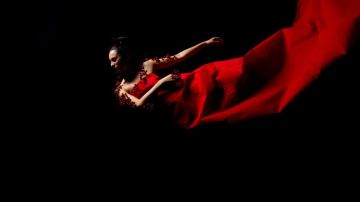Flamen-qué? How Olga Pericet Redefines Flamenco
Taking the stage at the Repertorio Español in a brightly colored geometric red, yellow, and blue dress, world-renowned flamenco star Olga Pericet appeared just briefly, leaving the audience wondering exactly what to expect

Photo: Unsplash/gracefulgreiss
Taking the stage at the Repertorio Español in a brightly colored geometric red, yellow, and blue dress, world-renowned flamenco star Olga Pericet appeared just briefly, leaving the audience wondering exactly what to expect. Yet within minutes, the suspense was over. She held up to what the New York Times called a “powerhouse performance”. We won’t spoil too much for you, since we want you to check it out yourself, but here’s how Olga impressed us most.
The show really functions on two levels — showcasing both the diversity of the origins of flamenco as well as its diversity as an art form. It’s the ensemble as a whole who shows that flamenco is more than just a Spanish musical genre from Andalusia. Their instruments and sounds demonstrate flamenco’s diversity of Latin American and Spanish origins. This parallels the diversity in Ms. Pericet’s individual performance — where she highlights flamenco’s diversity and complexity in being much more than just a dance. It’s a full on theatrical display that would be incomplete without her emotion, performance, acting, and interpretive style. And without seeing flamenco represented this way before, perhaps we’re not to blame for not realizing how complex of an art form it really is. Even the iPhone has trivialized flamenco down to the red dress dancer emoji.
As the female headliner of her self-titled show, we see how Ms. Pericet goes beyond simply dancing. Her contrast in movements conveys an almost overwhelming variety of emotions to the audience. It’s both the style of dance and the way she positions her body, gaze, and footwork that results in times of soft tenderness and other moments of intense, almost violent passion. And it isn’t just through her movements — her continuous wardrobe changes are not only impressive, but they help to illustrate the individual chapters of the larger flamenco story that she tells on stage. From the traditional and elegant red flamenco dress, to a simplistic black pantsuit, to her elaborate headwear and colorfully embroidered shawls, Ms. Pericet’s changes in attire are as essential a part of communicating her story and feelings as the dances are themselves. She effectively uses all of these elements together to prove how flamenco is so much more than just a dance.
Her three accompanying musicians — vocalists Miguel Lavi and Manuel Gago and guitarist Antonia Jimenez Arenas—serve as an equally critical part of the show. They highlight the diversity of flamenco and its origins in a way that would be incomplete through Pericet’s dancing alone. As the show opens, it is Gago, Lavi, and Jimenez who carry the musical complexity of the first song — a guajira — with rhythms from both Latin America and Spain. This is key in demonstrating the diversity of flamenco in a historical context. It’s not only a Spanish style of music, but rather a genre that has evolved over time because of Latin America’s intertwined history with Spain.
Ms. Pericet’s interpretation of the Andalusian tango further delves into the development of flamenco forms in both the Old and New Worlds. While modern day Argentinian and Andalusian tangos are quite distinct, some scholars have actually stated that tango developed in predominantly black neighborhoods in Cuba in the early 1800s, before later moving on to Spain and ultimately Argentina by the early 1900s. And if we haven’t convinced you yet that this show is more than your run-of-the-mill flamenco number at that tourist trap restaurant, this performance is perhaps the most impassioned of the night. You might have heard the expression that it takes two to tango, but Ms. Pericet single-handedly steals the show with this sensual display.
So don’t miss out—you can get tickets to see Olga Pericet and her ensemble almost nightly until September at the Repertorio Español on East 27th Street in New York City. You’ll start thinking about the flamenco emoji on your iPhone in a whole different light.

















